VEHICLE EXHIBITS Stand by Stand
Page 118
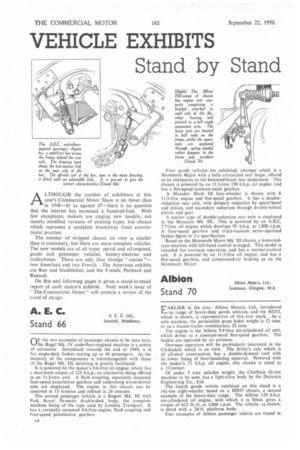
Page 119
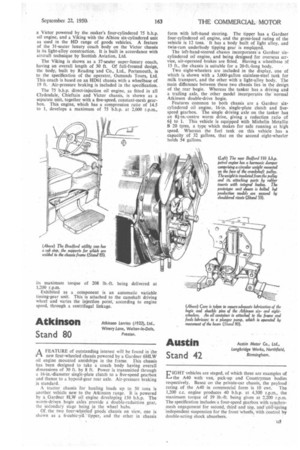
Page 120
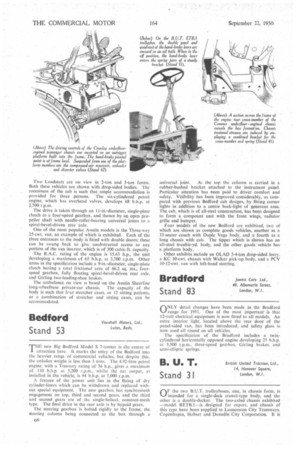
Page 125
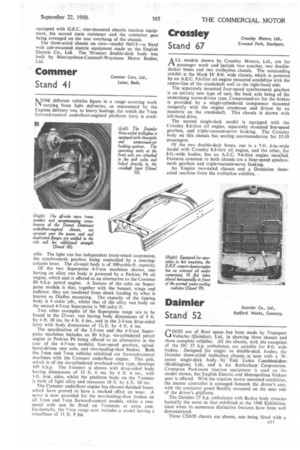
Page 126
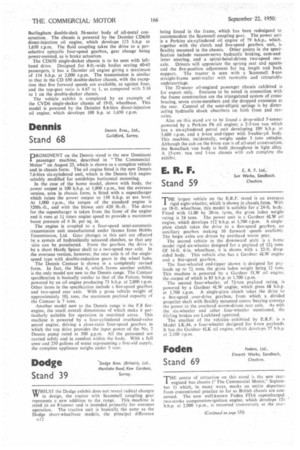
Page 135
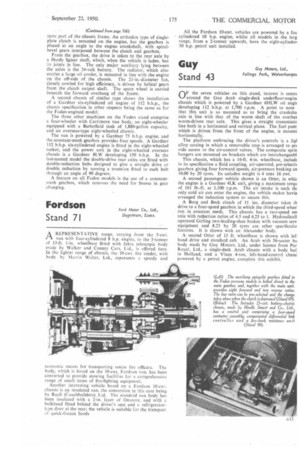
Page 136
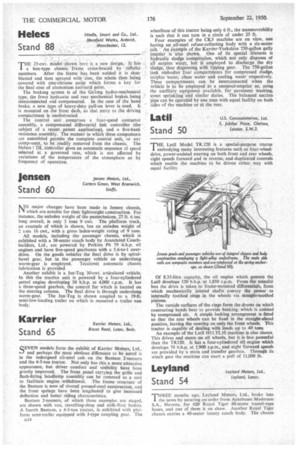
Page 141

Page 142
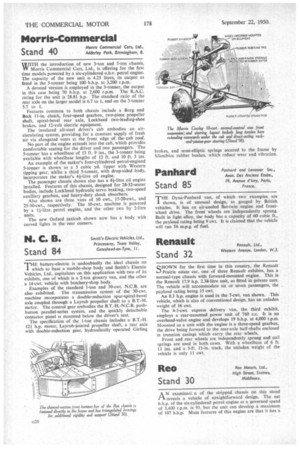
Page 143
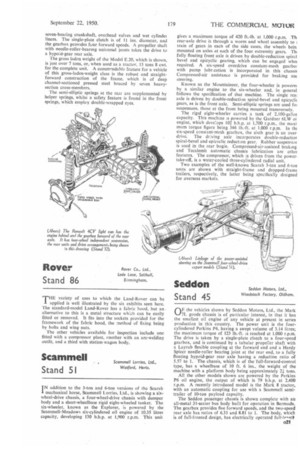
Page 144
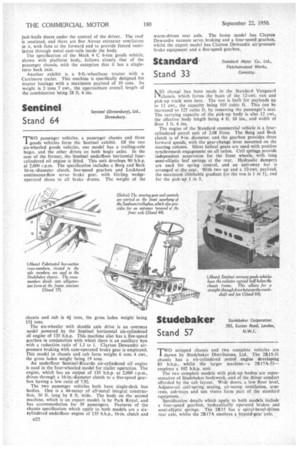
Page 145
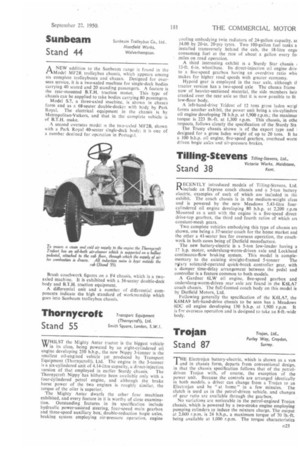
Page 146
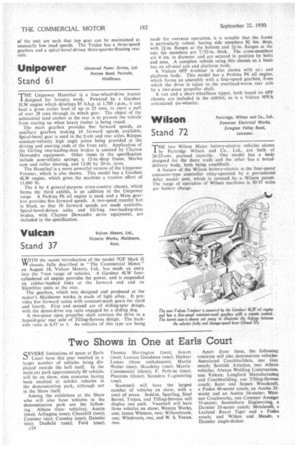
If you've noticed an error in this article please click here to report it so we can fix it.
ALTHOUGH the number of exhibitors at this year's Commercial Motor Show is six fewer than in 1948-41 as against 47—there is no question that the interest has increased a hundred-fold. With
few exceptions, makers are staging new models; not merely modified versions of existing types, but chassis
which represent a complete breakaway from conventional practice.
The number of stripped chassis on view is smaller
than is customary, but there are more complete vehicles. The new models are of all types. petrol and oil-engined,
goods and passenger vehicles, battery-electries and trolleybuses. There are only four foreign "entries "two American and two French The American exhibits are Reo and Studebaker, and the French, Panhard and Renault.
On this and following pages is given a stand-to-stand report of each maker's exhibits. Next week's issue of
"The Commercial Motor" will contain a review of the trend of design.
A. E. C. A. E. C. Ltd„ Stand 66 Southall, Middlesex.
OF the two examples of passenger chassis to be seen here, the Regal Mk. IV underfloor-engined machine is a centre of attraction. Introduced towards the end of 1949, it is for single-deck bodies seating up to 44 passengers. As the majority of the components is interchangeable with those of the Regal Mk. 111, servicing is greatly facilitated.
It is powered by the maker's 9.6-litre oil engine, which has a maximum output of 125 b.h.p., an alternative being offered in an 11.3-litre unit. A fluid coupling, separately mounted four-speed preselective gearbox and underslung worm-driven axle are employed. The engine in this chassis can be removed in 13 minutes and refitted in 24 minutes.
The second passenger vehicle is a Regent Mk. III with Park Royal 56-seater doubie-deck body, the complete machine being of the type used by London Transport. It has a vertically mounted 9.6-litre engine, fluid coupling and four-speed preselective gearbox.
Four goods vehicles are exhibited, amongst which is a Mammoth Major with a fully articulated rear bogie.. offered . as an alternative to the balanced-beam rear suspension. This chassis is powered by an 11.3-litre 150 b.h.p. oil engine, and has a five-speed constant-mesh gearbox.
A Matador Mark III four-wheeler is shown with 11.3-litre engine and five-speed gearbox. It has a doublereduction rear axle, with primary reduction by spiral-bevel and pinion, and secondary reduction through dotible-helical pinion and gear.
A similar type of double-reduction rear axle is employed in the Monarch Mk 111. This is powered by an A.E.C. 7.7-litre oil engine which develops 95 b.h.p. at 1,800 r.p.m. A • four-speed gearbox and tripe-vacuum servo-operated briakes•figure in'ti.e specification.
Rased on the Mammoth Major Mk 111 chassis, a bonnetedtype machine with left-hand control is staged. This model is intended for' overseas operation, and has a normal-control cab. It is powered by an 11.3-litre oil engine, and has a five-speed gearbox, and compressed-air braking as on the Mammoth Major.
Albion Albion Mows, Ltd., Stand 70 Scotstoun, Glasgow, W.4.
EARLIER in the year, Albion Motors. Ltd., introduced its range of heavy-duty goods vehicles, and the HD53, which is shown, is representative of this new mark. As a solo machine, the permissible gross laden weight is 12 tons, or as a tractor-trailer combination, 22 tons.
The engine is the Albion 9.9-litre six-cylindered oil unit, which drives to a constant-mesh five-speed gearbox. The brakes are operated by air pressure. Overseas operators will be particularly interested in the Clydesdale which is on view. The driver's cab, which is of all-steel construction, has a double-skinned roof with its lower lining of heat-insulating material. Powered with the maker's 75 b.h.p. oil engine, this chassis is rated as a 12-tonner.
Of under 3 tons unladen weight, the Chieftain 61-ton machine to be seen, has a light-alloy body by the Duramin Engineering Co., Ltd.
The fourth goods vehicle exhibited on this stand is a 14i-ton eight-wheeler based on a HD57 chassis, a second example of the heavy-duty range_ The Albion 120 b.h.p. six-cylindered oil engine, with which it is fitted, gives a torque of 412 lb.-ft. at 1,000 r.p.m. The vehicle, as shown, is fitted with a 24-ft. platform body.
Two examples of Albion passenger vehicle are found in a Victor powered by the maker's four-cylindered 75 b.h.p. oil engine, and a Viking with the Albion six-cylindered unit as used in the HD range of goods vehicles. A feature of the 31-seater luxury coach body on the Victor chassis is its light-alloy construction. It is built in accordance with aircraft technique by Scottish Aviation, Ltd.
The Viking is shown as a 37-seater super-luxury coach, having an overall length of 30 ft. Of full-fronted design, the body, built by Reading and Co., Ltd., Portsmouth, is to the specification of the operator, Osmands Tours, Ltd. This coach is based on an HD6I chassis with a wheelbase of 19 ft. Air-pressure braking is included in the specification.
The 75 b.h.p. direct-injection oil engine, as fitted in all Clydesdale, Chieftain and Victor chassis, is shown as a separate unit, together with a five-speed, constant-mesh gearbox. This engine, which has a compression ratio of 14.5 to 1, develops a maximum of 75 b.h.p. at 2,000 r.p.m., its maximum torque of 208 lb.-ft. being delivered at 1,200 r.p.m.
Exhibited as a component is an automatic variable tinting-gear unit. This is attached to the camshaft driving wheel and varies the injection point, according to engine speed, through a centrifugal linkage.
Atkinson Atkinson Lorries (1933), Ltd.,
Winery Lane, Walton-le-Dole,
Stand 80 Preston.
A FEATURE of outstanding interest will be found in the
new four-wheeled chassis powered by a Gardner 6HLW oil engine mounted amidships in the frame. rhis chassis has been designed to take a coach body having overall dimensions of 30 ft. by 8 ft. Power is transmitted through a 16-in.-diameter single-plate clutch to a five-speed gearbox and thence to a hypoid-gear rear axle. Air-pressure braking is standard.
A tractor chassis for hauling loads up to 50 tons is another vehicle new to the Atkinson range. It is powered by a Gardner 81W oil engine developing 150 b.h.p. The worm-driven bogie axles provide a double-reduction gear, the Secondary.; stage being in the wheel hubs.
Of the two four-wheeled goods chassis on view, one is shown as a 6-cubic-yd. tipper, and the other in chassis form with left-hand steering. •The tipper has a Gardner four-cylindered oil engine, and the gross-load rating of the vehicle is 12 tons. It has a body built of light alloy, and twin-ram underbudy tipping gear is employed.
The left-hand-steered chassis incorporates a Gardner sixcylindered oil engine, and being designed for overseas service, air-operated brakes are fitted. Having a wheelbase of 15 ft., the chassis is suitable for a 20-ft.-long body.
Two eight-wheelers are included in the display, one of which is shown with a 3,000-gallon stainless-steel tank for milk transport, and the other with a light-alloy body. The main difference between these two chassis lies in the design of the rear bogie. Whereas the tanker has a driving and a trailing axle, the other model incorporates the normal Atkinson double-drive bogie.
Features common to both chassis are a Gardner sixcylindered oil engine, 16-in, single-plate clutch and fivespeed gearbox. The single driving axle on the tanker has an 81-in.-centre worm drive, giving a reduction ratio of 6f to 1. This vehicle is equipped with Michelin Metallic B 20 tyres, a type which makes for safe running at high speed. Whereas the fuel tank on this vehicle has a capacity of 32 gallons, that on the second eight-wheeler holds 54 gallons.
Austin Austin Motor Co., Ltd.,
Longbridge Works, Northfield,
Stand 42 Birmingham.
EIGHT vehicles are staged, of which three are examples of the A40 with van, pick-up and Countryman bodies respectively. Based on the private-car chassis, the payload rating of the A40 in commercial form is 10 cwt. The 1,200 c.c. engine produces 40 b.h.p. at 4,300 r.p.m., the maximum torque of 59 lb.-ft. being given at 2,200 r.p.m. The specification includes a four-speed gearbox with synchromesh engagement' for second, third and top, and'cbil-:spring independent suspension for the front wheels, with Control by double-acting shock absorbers. Two Loadstars are on view in 2-ton and 5-ton forms. Both these vehicles are shown with drop-sided bodies. The roominess of the cab is such that ample accommodation is provided for three persons. The six-cylindered petrol engine, which has overhead valves, develops 68 b.h.p. at 2,700 r.p.m.
The drive is taken through an 11-in.-diameter, single-plate clutch to a four-speed gearbox, and thence by an open propeller shaft with needle-roller-bearing universal joints to a spiral-bevel-driven rear axle.
One of the most popular Austin models is the Three-way 25-cwt, van, an example of which is exhibited. Each of the three entrances to the body is fitted with double doors; these can be swung back to give unobstructed access to any portion of the van interior, which is of 300 cubic ft. capacity.
The R.A.C. rating of the engine is 15.63 h.p., the unit developing a maximum of 65 b.h.p. at 3,700 r.p.m. Other items in the specification include a 9-in.-diameter, single-plate clutch having a total frictional area of 66.2 sq. ins., fourspeed gearbox, fully floating spiral-bevel-driven rear axle, and Girling two-leading-shoe brakes.
The ambulance on view is based on the Austin Sheerline long-wheelbase private-car chassis. The capacity of the body is such that feur stretcher cases, or 12 sitting patients, or a combination of stretcher and sitting cases, can be accommodated.
Bedford Vauxhall Motors, Ltd., Stand 53 Luton, Beds.
THE new Big Bedford Model S 7-tonner is the centre of attraction here. It marks the entry of the Bedford into the heavier range of commercial vehicles, but despite this. the unladen weight is less than 3 tons. The 4.92-litre petrol engine, with a Treasury rating of 36 h.p., gives a maximum of 110 b.h.p. at 3,200 r.p.m.„ whilst the net output, as installed in the vehicle, is 94 b.h.p. at 3,000 r.p.m.
A feature of the power unit tics in the fitting of dry cylinder-liners which can be withdrawn and replaced without special equipment. The new gearbox has synchromesh engagement on top, third and second gears, and the third and second gears are of the single-helical, constant-mesh type. The final drive in the rear axle is by hypoid gears.
The steering gearbox is bolted. rigidly to the frame, the steering column being connected to the box through a universal joint. At the top the column is carried in a rubber-bushed bracket attached to the instrument panel. Particular attention has been paid to driver comfort and safety. Visibility has been improved considerably, as compared with previous Bedford cab designs, by fitting corner lights in addition to a centre back-light of generous area. The cab, which is of all-steel construction, has been designed to form a composite unit with the front wings, radiator grille and bumper.
Four models of the new Bedford are exhibited, two of which are shown as complete goods vehicles, another as a 33-seater coach with Duple Vega body, and a fourth as a long chassis with cab. The tipper which is shown has an all-steel 6-cubic-yd. body, and the other goods vehicle has• a platform body.
Other exhibits include an OLAD 3-4-ton drop-sided lorry. a KC 30-cwt. chassis with Walker pick-up body, and a PCV 10-12-cwt. van with left-hand steering.
Bradford Jowett Cars Ltd., 48, Albemarle Street, Stand 83 London, W.1 ONLY detail changes have been made in the Bradford range for 1951. One of the most important is that 12-volt electrical equipment is now fitted to all models. An extra interior light, located above the rear door of the panel-sided van, has been introduced, and safety glass is now used all round on all vehicles.
The specification of the Bradford includes a twincylindered horizontally opposed engine developing 25 b.h.p. at 3,500 r.p.m., three-speed gearbox, Girling brakes, and semi-elliptic springs.
B. U. T. British United Traction, Ltd.,
14, Hanover Square,
Stand 31 London, W.I.
OF the two B.U.T. trolleybuses, one, in chassis form, is intended for a single-deck transit-type body, and the other is a double-decker. The two-axled chassis exhibited —model RETB.1—is designed for export, and chassis of this type have been supplied to Launceston City Tramways. Copenhagen, Hobart and Dunedin City Corporation. It is
equipped with G.E.C. rear-mounted electric traction equipment, the second main resistance and the contactor gear being arranged on the rear overhang of the chassis.
The three-axled chassis on view—model 9641T—is fitted with cab-mounted electric equipment made en/ the English Electric Co., Ltd. The 70-seater double-deck body was built by Metropolitan-Carnmell-Weymann Motor Bodies, Ltd.
Commer Commer Cars, Ltd., Stand 41 Luton, Beds.
NlNE different vehicles figure in a lange covering work varying from light deliveries, as represented by the Express delivery van, to heavy haulage, for wnich the 7-ton forward-control underfloor-engined platform lorry is avail
able. The light van has independent tront-wheel suspension, the synchromesh gearbox being controlled by a steeringcolumn lever. The all-steel body is of 100-cubic-ft. capacity.
Of the two Superpoise 4-5-ton machines shown, one having an alloy van body is powered by a Perkins P6 oil engine, which unit is offered as an alternative to the Commer 80 b.h.p. petrol engine. A feature of the cabs on Superpoise models is that, together with the bonnet, wings and radiator, they are insulated from shock loading by what is known as Diaflex mounting. The capacity of the tipping body is 4 cubic yds., whilst that of the alloy van body on the second 4-5-ton Superpoise is 700 cubic ft.
Two other examples of the Superpoise range are to be found in the 25-cwt. van having body dimensions of 9 ft. by 4 ft. 10 ins. by 4 ft. 6 ins., and in the 2-3-ton drop-sided lorry with body dimensions of 125 ft. by 6 ft. 6 ins.
The specification of the 2-3-ton and the 4-5-ton Superpoise machines includes an 80 b,h.p. six-cylindered petrol engine (a Perkins P6 being offered as an alternative in the case of the 4-5-ton models), four-speed gearbox, spiralbevel-driven rear axle, and two-leading-shoe brakes. Both the 5-ton and 7-ton vehicles exhibited arc forward-control machines with the Commer underfloor engine. This unit, which is of the six-cylindered overhead-valve type, develops 109 b.h.p. The 5-tonner is shown with drop-sided body having dimensions of 15 ft. 6 ins. by 6 ft. -6 ins., with 1-ft. 6-in, sides, whilst the platform body on the 7-tanner is built of light alloy and measures18 ft. by 6 ft. 10, ins:
The Commer underfloor engine has chrome-finished bores, which have proved to have a marked effect on wear. A servo is now provided for the two-leading-shoe brakes on all 5-ton and 7-ton forward-control models, whilst a twospeed axle can be fitted on 7-tanners at extra cost. Incidentally, the 7-ton range now includes a model having a wheelbase of 11 ft. 9 ins.
Crossley Crossley Motors, Ltd., Stand 67 Errwood Park, Stockport.
ALL models shown by Crossley Motors, Ltd., are for passenger work and include two coaches, two doubledecker buses and two trolleybus chassis. The outstanding exhibit is the Mark IV 8-ft. wide chassis, which is powered by an A.E.C. 9.6-litre oil engine mounted amidships with the centre-line of the crankshaft well to the right-hand side.
The separately mounted four-speed synchromesh gearbox is an entirely new type of unit, the back axle being of the underslung worm-driven type. Compressed-air for the brakes is provided by a single-cylindered compressor mounted integrally with the engine crankcase and driven by an eccentric on the crankshaft. This chassis is shown with left-hand drive.
The second single-deck model is equipped with the Crossley 8.6-litre oil engine, separately mounted five-speed gearbox, and triple-vacuum-servo braking. The Crossley body on this chassis has seating accommodation for 37-39 passengers.
Of the two double-deck buses, one is a 7-ft, 6-in.-wide model with Crossley 8.6-litre oil engine, and the other, for 8-ft,-wide bodies, has an A.E.C. 9.6-litre engine installed. Features common to both chassis are a four-speed synchromesh gearbox and triple-vacuum-servo braking.
An Empire two-axled chassis and a Dominion threeaxled machine form the trolleybus exhibits.
Daimler Daimler Co„ Ltd., Stand 52 Radford Works, Coventry.
GOOD use Of floor space has been made by Transport Vehicles (Daimler), Ltd„ in showing three chassis and three complete vehicles. All the chassis, with the exception of the DC 27 .h.p. ambulance,. are _suitable for 8-ft. wide bodies. Designed for singleor double-deck bodies, the Daimler three-axled trolleybus chassis is seen with a 38seater single-deck body by East Lancs Coachbuildels (Bridlington), Ltd., and is for Rotherham Corporation. Crompton Parkinson traction equipment is used on the model shown, but English Electric and Metropolitan Vickers gear is offered. With the traction motor mounted amidships, the master controller-is arranged beneath the driver's seat, with the contactor panel flexibly mounted on the near side of the driver's platform.
The Daimler 27 h.p. ambulance with Barker body remains basically the same as that exhibited at the 1948 Exhibition, since when its numerous distinctive features have been well demonstrated.
Three CD650 chassis are shown, one being fitted with a ol 1
Burlingham double-deck 56-seater body of all-metal con, struction. The chassis is powered by the Daimler CD650 direct-injection oil engine, which develops 123 b.h.p at 1,650 r.p.m, The fluid coupling takes the drive to a preselective epicyclic four-speed gearbox, gear change being power-assisted, as is brake actuation.
The CD650 single-decker chassis is to be seen with lefthand drive. Designed for 8-ft.-wide bodies seating 40-45 passengers, it has a Daimler oil engine giving a maximum of 134 b.h.p. at 2,000 r.p.m. The transmission is similar to that in the CD 650 double-decker chassis, with the exception that five forward speeds are available, as against four, and the top-gear ratio is 4.67 to 1, as compared with 5.16 to I on the double-decker chassis.
The vehicle exhibit is completed by an example of the CVD6 single-decker chassis of I9-ft. wheelbase. This model is powered by the Daimler 8.6-litre direct-injection oil engine, which develops 100 h.p. at 1,650 r.p.m.
Dennis Dennis Bros., Ltd., Stand 68 Guildford, Surrey.
PROMINENT on the Dennis stand is the new Dominant passenger machine, described in "The Commercial Motor" on August 25, which is shown as a complete vehicle and in chassis form. The oil engine fitted is the new Dennis 7.6-litre six-cyindered unit, which is the Dennis 0.6 engine suitably modified for amidships horizontal mounting.
In the case of the home model, shown with body, the power output is 100 b.h.p. at 1,800 r.p.m., but the overseas version, seen in chassis form, is fitted with a supercharger which raises the power output to 130 b.h.p. at sea level. At 1,000 r.p.m., the torque of the standard engine is 3201b.-ft., and with the blown unit 420 lb.-ft. The drive for the supercharger is taken from the front of the engine and it runs at I times engine speed to provide a maximum boost pressure of 6 lb. per sq. in.
The engine is coupled to a four-speed semi-automatic transmission unit manufactured under licence from Hobbs Transmission, Ltd. Gear changes in this unit are effected by a system of hydraulically actuated clutches, so that any :atio can be preselected. From the gearbox the drive is by a short Hardy Spicer shaft to a two-speed rear axle. In the overseas version, however, the rear axle is of the singlespeed type with double-reduction gears in the wheel hubs.
The Dennis Centaur is shown in a completely revised form. In fact, the Max 6, which forms another exhibit, is the only model not new to the Dennis range. The Centaur specification is basically similar to that of the Falcon, being powered by an oil engine producing 75 b.h.p. at 2,000 r.p.m. Other items in the specification include a five-speed gearbox and two-speed rear -axle. With a gross vehicle weight of approximately 10i tons, the maximum payload capacity of the Centaur is 7 tons.
Another model new to the Dennis range is the F.8 fireengine, the small overall dimensions of which make it particularly suitable for operation in restricted areas. This machine is powered by a four-cylindered overhead-valve petrol engine, driving a close-ratio four-speed gearbox in which the top drive provides the input power of the No. 2 Dennis pump rated at 500 g.p,m. All the personnel are carried safely and in comfort within the body. With a full crew and 250 gallons of water representing a first-aid supply, the complete appliance weighs under 5 tons
Dodge 'Dodge Bros. (Britain), Ltd.,
Mordoke Road, Kew Gardens,
Stand 39 Surrey.
WHILST the Dodge exhibit does not reveal radical changes WV in design, the tractor with Scammell coupling gear represents a new addition to the range. This -machine is rated .as an 8-tonner and is intended primarily for overseas operation. The tractive unit is basically the same as the Dodge short-wheelbase models, the principal difference c12 being found in the frame, which has been redesigned to accommodate the Scammell coupling gear. The power unit is a Perkins six-cylindered oil engine of 79 b.h.p., which, together with the clutch and live-speed gearbox unit, is flexibly tnounted in the chassis. Other points in the specification include vacuum-servo hydraulic braking, cam-andlever steering, and a spiral-bevel-driven two-speed rear axle. Drivers will appreciate the sprung seat and squabs and the five-position adjustment for leg length and back support. The tractor is seen with a Scammell 8-ton straight-frame semi-trailer with turntable and retractable undercarriage.
The 32-seater oil-engined passenger chassis exhibited is for export only. Features to be noted in connection with the frame construction are the triangulated system of crossbracing, seven cross-members and the dropped extension at the rear. Control of the semi-elliptic springs is by directacting hydraulic shock absorbers on both front and real axles.
Also on this stand are to be found a drop-sided 5-tonner powered by a Perkins P6 oil engine; a 2-3-ton van which has a six-cylindered petrol unit developing 109 b.h.p. at 3,600 r.p.m. and a 6-ton end-tipper with 5-cubic-yd. hods. This machine, incidentally, weighs under 3 tons unladen. Although the cab on the 6-ton van is of all-steel construction, the Bonallack van body is built throughout in light alloy. A 15-cwt. van and 1-ton chassis with cab complete the exhibit.
E. Re F. E. ft. F. Ltd.,
Sun Works, Sandbach,
Stand 59 Cheshire.
THE largest vehicle on the E.R.F. stand is an overseas rigid eight-wheeler, which is shown in chassis form. With an 18-ft. wheelbase, this model is suitable for a 24-ft. body. Fitted with MOO by 20-in. tyres, the gross laden weight rating is 24 tons. The power unit is a Gardner 6LW oil engine, which develops 112 b.h.p. at 1,700 r.p.m. A singleplate clutch takes the drive to a five-speed gearbox. an auxiliary gearbox making 10 forward speeds available. The bogie axles are driven by overhead worm gear.
The second vehicle in the downward scale is a home model rigid six-wheeler designed for a payload of 12i tons. Of 16-ft. 6-in, wheelbase, it is shown with a 22-ft. dropsided body. This vehicle also has a Gardner 61W engine and a five-speed gearbox. The four-wheeled end-tipper shown is designed for payloads up to 71 tons, the gross laden weight being 12 tons. This machine is powered by a Gardner 5LW oil engine, the output of which is 85 b.h.p. at 1,700 r.p.m.
The second four-wheeler, of 7f-ton payload rating, is powered by a Gardner 41_W engine, which gives 68 b.h.p. at 1,700 r.p.m. A single-plate clutch takes the drive to a five-speed over-drive gearbox, from which a divided propeller shaft with flexibly mounted centre bearing conveys the power to the overhead worm-driven rear axle. As with the six-wheeler and other four-wheeler mentioned, the Girling brakes are Lockheed operated.
The smallest of the vehicles exhibited by E.R.F. is a Model LK.44, a four-wheeler designed for 6-ton payloads. It has the Gardner 41K oil engine, which develops 57 b.h.p. at 2,100 r.p.m.
Foden Fodens, Ltd.,
Elworth Works, Sandbach,
Stand 69 Cheshire.
'1"HE centre of attraction on this stand is the new rear' engined bus chassis (" The Commercial Motor," September 1) which, in many ways, marks an entire departure from conventional practice so far as British chassis are concerned. The now well-known Foden FD.6 supercharged. two-stroke compression-ignition engine, which develops 126 b.h.p. at 2,000 r.p.m., is mounted transversely at the rear
most part of the chassis frame. An orthodox type of singleplate clutch is mounted on the engine, but the gearbox is placed at an angle to the engine crankshaft, with spiralbevel gears interposed between the clutch and gearbox.
From the gearbox, the drive is taken to the rear axle by a Hardy Spicer shaft, which, when the vehicle is laden, has its joints in line. The only major auxiliary lying between the axles is the 24-volt battery. The radiator, which also carries a large oil cooler, is mounted in line with the engine on the off-side of the chassis. The 21-in.-diameter fan, closely cowled for high efficiency, is driven by helical gears from the clutch output shaft. The spare wheel is carried beneath the forward overhang of the frame.
A second chassis of similar type shows the installation of a Gardner six-cylindcred oil engine of 112 b.h.p.,. the chassis specification in other respects being the same as for the Foden-engined modeL The three other machines on the Foden stand comprise a four-wheeler with Carrimore van body, an eight-wheeler equipped with a Butterfield tank of 1,880-gallon capacity, and an overseas-type eight-wheeled chassis.
The van is powered by a Gardner 75 b.h.p. engine, and the constant-mesh gearbox provides four speeds. A Gardner 112 b.h.p. six-cylindered engine is fitted in the eight-wheeled tanker, and the power unit in the eight-wheeled overseas chassis is a Gardner 8LW developing 150 b.h.p. In the last-named model the double-drive rear axles are fitted with double-reduction hubs designed to give a straight drive or double reduction by turning a trunnion fitted to each hub through an angle of 90 degrees.
A feature on all Foden models is the use of a constantmesh gearbox, which removes the need for finesse in gear changing.
Fordson Ford Motor Co., Ltd., Stand 71 Dagenham, Essex.
AREPRESENTATIVE range, varying from the 5-cwt. van with four-cylindered 8 h.p. engine, to the 5-tonner of 13-ft. 1-in, wheelbase fitted with Jekta .telescopic body made by Walker and County Cars, Ltd., is offered here. In the lighter, range of chassis, the 10-cwt. tire tender, with body by Nlartin Walter, Ltd., represents a speedy and
economic means for transporting senior fire officers. The body, which is based on the 10-cwk. Fordson van, has been converted to provide stowing facilities for a comprehensive range of small items of fire-fighting equipment.
Another interesting vehicle based on a Fordson 10-cwt. chassis is an insulated van, the conversion in this case being by Reall (Coacirbuilders), Ltd. The standard van body has been insulated with a 2-in, layer of Onazote, and with a bulkhead fitted behind the driver's seat and a refrigeratort!, pe door at the rear; the vehicle is suitable for the transport of quick-frozen foods All the Fordson 10-cwt. vehicles are powered by a fou cylinidered 10 h.p. engine, whilst all models in the tars range, from a 2-tonner upwards, have the eight-cylinder 30 h.p. petrol unit installed.
Guy Guy Motors, Ltd..
Stand 43 Fallings Park,, Wolverhampto OF the seven vehicles on this stand, interest is centri around the Guy Arab single-deck underfloor-engint chassis which is powered by a Gardner 6HLW oil engit developing 112 b.h.p. at 1,700 r.p.m. A point to note that this unit is so mounted as to bring the cranksha axis in line with that of the worm shaft of the overhea worm-driven rear axle. This gives a straight transmissic line both in a horizontal and vertical plane. The fuel pum which is driven from the front of the engine, is mounte horizontally.
The platform embracing the driver's controls is a .ligl alloy casting in which a removable trap is arranged to pri vide access to the air-control valves. Tbe composite sprir hangers are mounted on brackets which are interchangeabl This chassis, which has a 16-ft. 4-in. wheelbase, include in its specification a fluid coupling, air-operated, pre-selectis gearbox giving four forward speeds, air-pressure braking an 10.00 by 20 tyres. Its unladen weight is 4 tons 16 cwt.
A second passenger vehicle shown is an Otter, in whic the engine is a Gardner 4LK unit, giving a maximum torqu of 161 lb.-ft. at 1,100 r.p.m. The air intake is such thi only cold air can enter the engine, the vehicle maker havin arranged the induction system to secure this.
A Borg and Beck clutch of 11 ins, diameter takes th drive to a four-speed gearbox in which the third-speed whee' run in constant mesh. This chassis has a two-speed rea axle with reduction ratios of 4.5 and 6.25 to 1. Hydraulicall operated Girling two-leading-shoe brakes with vacuum serv equipment and 8.25 by 20 tyres are other specificatio features. It is shown with an Alexander body.
A second Otter of 13 ft. wheelbase is shown with lefi hand drive and standard cab, An Arab with 56-seater bu body made by Guy Motors, Ltd., under licence from Par Royal, Ltd., a single-deck Arab chassis with a body buil in Holland, and a Vixen 4-ton, left-hand-control chassi powered by a petrol engine, complete this exhibit.
Helecs Hindle, Smart and Co., Ltd.,
Mere field Works, Ardwick,
Stand 88 Manchester, 12.
'THE 25-cwt. model shown here is a new design. fthas / a box-type chassis frame cross-braced by tubular members. After the frame has been welded it is shot: blasted and then sprayed with zinc, the whole then being covered with zinc-chrome paint which forms a key for the final coat of aluminium anti-acid paint.
The braking system is of the Girling hydro-mechanical type, the front hydraulic and rear mechanical brakes being interconnected and compensated. in the case of the hand brake, a new type of heavy-duty pull-on lever is used. It is mounted on the front dash, so that entry to the driving compartment is unobstructed.
The control unit comprises a four-speed contactor assembly, a compensated differential fink controller (the subject of a recent patent application), and a five-bank resistance assembly. The manner in which these components are assembled permits the complete. control unit, or any component, to be readily removed from the chassis. The Helees ( DL controller gives an automatic sequence of speed selected at. a governed rate, which is not affected by variations of the temperature of the atmosphere or by frequency of operation.
Jensen
Stand 60 Carters Green, West Bromwich, Jensen Motors, Ltd., Staffs.
MO major changes have been made in Jensen chassis,
11 which are-notable for their lightweight construction. For instance, the unladen weight of the pantechnicon, 27 ft. 6 ins. long overall, is only 3 tons 9 cwt. The platform truck, an example of which is shown, has an unladen weight of 2 tons 16 cwt., with a gross laden-weight rating of 9 Ions.
All models, including the passenger chassis, which is exhibited with a 38-seater coach body by Associated Coachbuilders, Ltd, are powered by Perkins P6 79 b.h.p. oil engines and have five-speed gearboxes with a 5.6-to-1 overdrive. On the goods vehicles the final drive is by spiralbevel gear, but in the passenger vehicle an undershing worm-gear is employed. Tecalemit automatic chassis Lubrication is provided.
Another exhibit is a Jen-Tug 30-ewt articulated vehicle. In this the tractive unit is powered by a four-cylindered petrol engine developing 30 b.h.p. at 4,000 r.p.m. It has a three-speed gearbox, the control for which is located on the steering column. The final drive is through underslung worm-gear. The Jen-Tug is shown coupled to a I9-ft. semi-low-loading trailer on which is mounted. a trailer van body.
Karrier Karrier Motors, Ltd., Stand 65 Biscot Road, Luton, Beds.
QEVEN models form the exhibit of Karrier Motors, Ltd., s-) and perhaps the most obvious difference to be noted is in the redesigned all-steel cab on the Bantam 2-tanners and the 4-5-ton tractor. Not only has this a more attractive appearance, but driver comfort and visibility have been greatly improved. The front panel carrying the grille and flush-fitting headlamp assembly can be removed as a unit to facilitate engine withdrawal. The frame -structure of the Bantam is now of riveted pressed-steel construction, and the front springs have been lengthened to give increased deflection and better riding characteristics.
Bantam 2-Ion:kers, of which three examples are staged, are shown with van, travelling-shop and milk-float bodies. A fourth Bantam, a 4-5-ton tractor, is exhibited with platform semi-trailer equipped with J-type coupling gear. The G14 wheelbase of this tractor being only 6 ft., the manoeuvrability is such that it can turn in a circle of under 25 ft.
Four examples of the CK3 machine are on view, one having an ,all-steel refuse-collecting body with a six-seater cab.' An exanaple of the Karrier-Yorkshire 750-gallon gully emptier is also shown., One of its special features is hydraulic sludge compression, which not only dispases of all surplus water, but IS employed to discharge the dry litclge; thus dispensing with 'tipping gear. The 750-gallon tank embodies four compartments for compressed sludge, 'surplus. Water, clean water and cooling water respectively. These compartments can be interconnected when the vehicle is to be employed as a cesspool-emptier or, using the aacillary equipment available, for pavement washing, street sprinkling and similar duties. The balanced suction pipe can he operated by one man with equal facility on both sides of the machine or at the rear.
Lath! U.S. Concessionaires, Ltd.
5, Jubilee Place, Chelsea,
Stand 50 London, S.W.3, THE Latil Model TR.I20 is a special-purpose tractor embodying many interesting features such as four-wheeldrive, power-assisted steering on both front and rear wheels, eight speeds forward and in reverse, and duplicated controls which enable the machine to be driven either way with equal facility
Of 8.35-litre capacity, the oil engine which powers the Latil develops 120 b.h.p. at 1,850 r.p.m. From the transfer box the drive is taken to frame-mounted differentials, from which mechanically jointed shafts convey the power to internally toothed rings in the wheels via straight-toothed pinions. The outside surfaces of the rings form the drums on which contracting bands bear to provide braking, which is assisted by compressed air. A simple locking arrangement is fitted so that the rear wheels can be fixed in the straight-ahead position, leaving the steering on only the front wheels. This tractor is capable of dealing with loads up to 40 tons.
An example of the Lail! H11.1-1-10 machine is also shown. This drives and steers on all wheels, but it is less powerful than the TR120. it has a four-cylindered oil engine which develops 70 b.h.p. at 1.900 r.p.m., and eight forward speeds are provided by a main and transfer gearbox. Through its winch gear the machine can exert a pull of 11,000 lb.
Leyland Leyland Motors, Ltd., Stand 54 Leyland, Lancs.
THREE months ago, Leyland Motors, Ltd., broke into 1 the news by securing an order from Autobuses Modernos S.A., Havana, for 620 Royal Tiger 40-seater transit-type buses, and one of them is on show. Another Royal Tiger chassis carries a 40-seater luxury coach body. The chassis has its Leyland 9.8-litre oil engine mounted horizontally beneath frame level, the mounting of this unit with clutch and gearbox being such that the whole assembly can be removed, replaced and started up within 50 m:nutes.
On the overseas version, brake application is by Westinghouse air-pressure equipment, a two-cylindered compressor delivering 11 cubic ft. of free air per minute. replacing the exhauster used in conjunction with the Clayton Dewandre triple-servo system as employed on four of the shortwheelbase models. The Leyland four-speed inertia-lock synchromesh gearbox is used, a short propeller shaft taking the drive to a spiral-bevel-driven rear axle.
The Saunders body on the 40-seater bus is of all-metal construction, and has power-assisted entrance and exit doors.
A third passenger vehicle exhibited is a Hybridge 60-seater double-deck bus, one of a number being supplied to Leicester Corporation. This is a new design, having been built to the new permissible maximum dimensions for double-deckers of 27 ft. by 8 ft. It is powered by a 9.8-litre oil engine developing 125 b.h.p. The chassis incorporates a quick-change synchromesh gearbox, an 8-in.-centre wormdriven rear axle, and vacuum-servo braking system.
Based on a Comet ECO.IR chassis, the mobile workshop on this stand is a well-equipped unit, having a sleeping Compartment in addition to two workshop rooms. The Comet chassis specification includes a two-speed rear axle with
ratios of 5.14 and 7.15 to I, a 75 b.h.p. oil engine and a five-speed gearbox.
A second Comet model is shown with platform body, being one of an order for 150 for Associated Portland Cement Manufacturers. Ltd. It is based on a standard Comet EC0.1 R chassis with hypoid rear axle of 6.16 to ratio.
An impressive exhibit is the Octopus eight-wheeler shown with 1,350-cubic-ft.-capacity van body by Thomas Allsop. Ltd. As staged it has hinged doors at the. rear, but when in service these will give place to a roller shutter.
The largest exhibit is the Model 22.01 with I7-ft. 9-in. wheelbase. Powered by a 125 b.h.p. oil engine, the chassis has a five-speed heavy-duty gearbox, and a two-piece propeller shaft driving to a double-drive rear bogie.
Maudslay Maudslay Motor Co,. Ltd., Stand 56 A/cester, Warwicks.
THE new Marathon Mk. IV 8-ft.-widz chassis with under' floor engine is the highlight of the Maudslay display. The engine is an A.E.C. 9.6-litre unit with fluid coupling. The four-speed preselective gearbox is separately mounted, the general layout following closely that of the A.E.C. Regal Mk. IV.
It is shown with a Park Royal 39-seater body incorporating pillars which eliminate timber fillings, enabling both exterior and interior panels to be riveted to the framing. There are two doors, both being operated by C.A.V. electric door gear under the control of the driver.
The second passenger model is also designed for overseas service, having left-hand drive and designed for 8-ft.-wide bodies. An A.E.C. 11.3-litre oil engine Is used, the unit being vertically mounted forward. The chassis specification includes a dry-plate clutch, five-speed constant-mesh gearbox, underslung worm-driven rear axle and compressedair braking.
An A.E.C. 7.7-litre oil engine powers the Marathon coach which forms the third passenger model. This is a singedecker machine and is shown with a Burlingham body.
Examples of the Mustang, Mentor and Mogul represent the Crossley range of goods vehicles. The Mustang is saown as an 8-ft.-wide chassis. It is a six-wheeler, having two axles at the front.
The Mentor is a rigid eight-wheeler powcied by an A.E.C. 9.6-litre oil engine. It has a five-speed gearbox and double-drive underslung worm-driven bogie axles. The chassis weight is 6 tons 14 cwt. 2 qtrs.
Also powered by a 9.6-litre oil engine, the four-wheeled Mogul exhibited has a five-speed gearbox, doubie-reduction rear axle and compressed-air braking.
Morris Mort is Motors, Ltd., Stand 58 Cowley, Oxford.
A LTHOUGH the new Morris-Cowley chassis specification Irt is based on that of the Morris Oxford private car, an essential difference is that, in its commercial-vehicle form, the vehicle has a back axle of lower ratio. The 120-cubic-ft. van body of one of the two exhibits is of all-steel construction, which makes for a complete vehicle weight of about 1 ton 2 cwt., the pay-load rating being 10 cwt. A
four-cylindered petrol engine provides the power, and this unit, which has a capacity of 1.47 litres, gives a maximum output of 40.5 b.h.p. at 4,000 r.p.rn. The four-speed gearbox has synchromesh engagement for second, third and top, the output shaft of the box being enclosed in an extension of the casing. This extension not only houses the selector and the gear-lock mechanism. but makes possible the use of a short propeller shaft. The semi-floating rear axle is driven by hypoid gears. At the rear the suspension is by semi-elliptic springs, with control by telescopic hydraulic dampers which prevent sway or body roll when cornering. Independent suspension through torsion bars and double-acting dampers is used for the front wheels.
By using steering-Column gear control, and arranging the brake lever alongside the steering-column tube, the floor is left free from obstruction:
Other exhibits are a Morris Cowley pick-up truck, two examples of the Morris 5-cwt. delivery van, and a 5-cwt. chassis.
Morris-Commercial
Stand 40
Morris Commercial Cars, Ltd., Adderley Park, birmingham, 8.
WITH the introduction of new 3-ton and 5-ton chassis, VW Morris Commercial Cars, Ltd., is offering for the first time models powered by a six-cylindered o.h.v. petrol engine. The capacity of the new unit is 4.25 litres, its output as fitted in the 5-tonner being 100 b.h.p. at 3,200 r.p.m.
A derated version is employed in the 3-tonner, the output in this case being 70 b.h.p. at 2,600 r.p.m. The R.A.C. rating for the unit is 28.81 h.p. The standard ratio of the rear axle on the larger model is 6.7 to 1, and on the 3-tonner 5.7 to 1.
Features common to both chassis include a Borg and Beck 1 1 in . clutch, four-speed gearbox, two-piece propeller shaft, spiral-bevel rear axle, Lockheed two-leading-shoe brakes, and 12-volt electric equipment.
The insulated all-steel driver's cab embodies an aircirculating system, providing for a constant supply of fresh air via elongated vents at the front edge of the cab roof.
No part of the engine extends into the cab, which provides comfortable seating for the driver and two passengers. The 5-tonner has a wheelbase of 13 ft. 9 ins., the 3-tonner being available with wheelbase lengths of 12 ft. and 10 ft. 3 ins.
An example of the maker's four-cylindered petrol-engined 5-tonner is shown as a 5 cubic yd. tipper with Western tipping gear, whilst a third 5-tonner, with drop-sided body, incorporates the maker's 41-litre oil engine.
The passenger chassis shown also has a 4flitre oil engine installed. Features of this chassis, designed for 28-32-seater bodies, include Lockheed hydraulic servo braking, two-speed auxiliary gearbox, and heavy-duty shock absorbers.
Also shown are three vans of 10 cwt., 15-20-cwt., and 25-30-cwt., respectively. The 10-cwt. machine is powered by a Ii-litre petrol engine, and the other two by 2-litre units.
The new Oxford taxicab shown now has a body with curved lights in the rear corners.
N. C. B. Stand 84 Smith's Electric Vehicles, Ltd., Princesway, Team Valley, Gateshead-on-Tyne, If.
THE battery-electric is undoubtedly the ideal chassis on which to base a mobile-shop body and Smith's Electric Vehicles, Ltd., capitalizes on this application with two of its exhibits, one of which is a 2-ton grocery van, and the other a 14-cwt. vehicle with butchery-shop body.
Examples of the standard 1-ton and 30-cwt. N.C.B. are also exhibited. The transmission system of the 30-cwt. machine incorporates a double-reduction spur-spiral-bevel axle coupled through a Layrub propeller shaft to a B.T.-H. motor. The control gear embodies the B.T.-H.-N.C.B. pushbutton parallel-series system, and the quickly detachable contactor panel is mounted below the driver's seat.
The specification of the I-ton chassis includes a B.T.-H. 121 h.p. motor, Layrub-jointed propeller shaft, a rear axle with double-reduction gear, hydraulically operated Curling
brakes, and semi-elliptic springs secured to the frame by Silentbloc rubber bushes, which reduce wear and vibration.
Panhard
Stand 85
Panhard and Levassar Soc., Anon. Des Anciens Etahs., 19, Avenue d'ivry, Paris, France.
THE Dyna-Panhard van, of which two examples are shown, is of unusual design, as gauged by British vehicles. It has an air-cooled flat-twin engine and frontwheel drive. The front wheels are independently sprung. Built in light alloy, the body has a capacity of 60 cubic ft., the payload rating being 9 cwt. It is claimed that the vehicle will run 56 m.p.g. of fuel.
Renault
Stand 32
Renault, Ltd., Western Avenue, London, W.3.
SH OWN for the first time in this country, the Renault Prairie estate car, one of three Renault exhibits, has a normal-type chassis with forward-mounted engine. This is the Renault 17.9 h.p. 2.38-litre unit, as fitted in private cars. The vehicle will accommodate six or seven passengers, the payload rating being 15 cwt.
An 8.3 h.p. engine is used in the 7-cwt. van shown. This vehicle, which is also of conventional design, has an unladen weight of 16 cwt.
The 4-5-cwt. express delivery van, the third exhibit, employs a rear-mounted power unit of 760 c.c. It is an overhead-valve engine and develops 19 b.h.p. at 4,000 r.p.m. Mounted as a unit with the engine is a three-speed gearbox, the drive being forward to the rear-axle half-shafts enclosed in trunnion casings which carry the rear wheels.
Front and rear wheels are independently sprung and coil springs are used in both cases. With a wheelbase of 6 ft. 11 ins, and a 3-ft. 11-in, track, the unladen weight of the vehicle is only 11 cwt.
Rea Rea Motors, Ltd.,
High Street, Staines,
Stand 30 Middlesex.
AN examinati, ri of the stripped chassis on this stand reveals a vehicle of straightforward design. The net b.h.p. of the six-cylindered petrol engine at a governed speed of 3,400 r.p.m. is 93, but the unit can develop a maximum
• of 107 b.h.p. Main features of this engine are that it has a seven-bearing crankshaft, overhead valves and wet cylindei liners. The single-plate clutch is of 11 ins_ diameter, and the gearbox provides futir forward speeds. A propeller shaft with needle-roller-bearing universal joints takes the drive to a hypo:d-gear rear axle.
The gross laden weight of the Model E.20, which is shown, is just over 7 tons, or, when used as a tractor. 13 tons 8 cwt. for the complete unit. A commemdable feature for a vehicle of this gross-laden-weight class is the robust and straightforward construction of the frame, which is of deep channel-sectioned pressed steel braced by seven heavysection cross-members, The semi-elliptic springs at the rear arc supplemented by helper springs, whilst a safety feature is found in the front springs, which employ double-wrapped eyes.
Rover over Co„ Ltd., Lode Lane, Solihull, Stand 86 Birmingham.
THE variety of uses to which the Land-Rover can be
applied is well illustrated by the six exhibits seen here. The standard-model Land-Rover has a fabric hood, but an• alternative to this is a metal structure which can be easily fitted or removed. It fits into the sockets provided for the framework of the fabric hood, the method of fixing being by bolts and wing nuts.
The other vehicles available for inspection include one fitted with a compressor plant, another with an arc-welding outfit, and a third with station-wagon body.
Scammell Scammell Lorries, Ltd., Stand 51 Watford, Herts.
TN addition to the 3-ton and 6-ton versions of the Scarab I mechanical horse, Scammell Lorries, Ltd., is showing a sixwheel-drive chassis, a four-wheel-drive chassis with dumper body and a short-wheelbase rigid eight-wheeled tanker. The six-wheeler, known as the Explorer, is powered by the Scammell-Meadows six-cylindered oil engine of 10.35 litres capacity, developing 130 b.h.p. at 1,900 r.p.m. This unit gives a maximum .torque of 420 ft.-lb. at 1,000 r.p.m. Th rear-axle drive is through a worm and wheel assembly to train of gears in each of the side cases, the wheels belt), mounted on axles at each of the four extremity gears. Th. fully floating front axle is driven by double-reduction spiral bevel and epicyclic gearing, which can be engaged whet required. A six-speed overdrive constant-mesh gearbo: with pump lubr.cation is incorporated in this chassis Compressed-air assistance is provided for braking ant steering.
Known as the Mountaineer, the four-wheeler is powerec by a similar engine to the six-wheeler and, in general follows the specification of that machine. The single mai axle is driven by double-reduction spiral-bevel and epicyclic gears, as is the front axle. Semi-elliptic springs are used foi suspension, those at the front being mounted transversely. The rigid eight-wheeler carries a tank of 2.100-gallot capacity. This machine is powered by the Gardner fiLW oi engine, which develops 102 h.h.p. at 1,700 r.p.m., the maxi mum torque figure being 346 lb.-ft. at 1.000 r.p.m. In thc six-speed constant-mesh gearbox, the sixth gear is an over drive. The dr;ving axle incorporates double-reductior spiral-bevel and epicyclic reduction gear. Rubber suspensiot is used in the rear bogie. Compressed-air-assisted braking and Tecalemit automatic chassis lubrication are othet features. The compressor, which is driven from the powertake-off, is a water-cooled three-cylindered radial unit.
Two examples of the well-known Scarab 3-ton and 6-ton units are shown with straight-frame and dropped-frame trailers, respectively, the latter being specifically designed for overseas markets.
Seddon Seddon Motors, Ltd., Stand 45 Woodstock Factory, Oldham.
OF the vehicles shown by Seddon Motors, Ltd., the Mark 7L goods chassis is of particular interest, in that it has the smallest oil engine of any vehicle at present in series production in this country. The power unit is the fourcyliudered Perkins P4, having a swept volume of 3.14 litres; the maximum torque of 123 lb.-ft. is reached at 1,000 r.p.m. The drive is taken by a single-plate clutch to a four-speed gearbox, and is continued by a tubular propeller shaft with a Layrub flexible coupling at the forward end and a Hardy Spicer needle-roller bearing joint at the rear end, to a fully floating hypoid-gear rear axle having a reduction ratio of 5.57 to 1. The chassis, which is of the full-forward-control type, has a wheelbase of 10 ft. 6 ins., the weight of the machine with a platform body being approximately 21 tons.
All the other models shown are powered by the Perkins P6 oil engine, the output of which is 79 b.h.p. at 2.400 r.p.m. A recently introduced model is the Mark 8 tractor, with an automatic coupling for use with a Scammell semitrailer of 10-ton payload capacity.
The Seddon passenger chassis is shown complete with an all-metal 31-seater bus body built for operation in Bermuda, The gearbox provides five forward speeds, and the two-speed rear axle has ratios of 6.33 and 8.81 to 1. The body, which is of full-fronted design, has electrically operated full-le•ncett, jack-knife doors under the control of the driver. The roof is Insulated, and there are five Airvac extractor ventilators in it, with fans at the forward end to provide forced ventilation through metal cant-rails inside the body.
The specification of the Mark 4 C 6-ton goods vehicle. shown with platform body, follows closely that of the passenger chassis, with the exception that it has a singleratio back axle.
Another exhibit is a 9-ft.-wheelbase tractor with a Carrimore trailer. This machine is specifically designed for tractor haulage with a maximum payload of 10 tons. Its weight is 2. tons 7 cwt., the approximate overall length of the combination being 28 ft. 6 ins.
Sentinel Sentinel (Shrewsbury), Ltd., Stand 64 Shrewsbury.
TgV0 passenger vehicles, a passenger chassis and three oods vehicles form the Sentinel exhibit. Of the two six-wheeled goods vehicles, one model has a trailing-axle bogie, and the other drives on both bogie axles. In the case of the former, the Sentinel underfloor horizontal fourcylindered oil engine is fitted. This unit develops 90 b.h.p. at 2,000 r.p.m. The specification includes a Borg and Beck 16-in.-diameter clutch, five-speed gearbox and Lockheed continuous-flow servo brake gear, with Girling wedgeoperated shoes in all brake drums. The weight of the chassis and cab is 41 tons, the gross laden weight being 151 tons.
The six-wheeler with double axle drive is an overseas model powered by the Sentinel horizontal six-cylindered ail engine of 135 b.h.p. This machine also has a five-speed gearbox in conjunction with which there is an auxiliary box with a reduction ratio of 1.3 to 1. Clayton Dewandre airpressure braking with cam-operated brake gear is employed. This model in chassis and cab form weighs 6 tons 4 cwt., the gross laden weight being 19 tons.
An underfloor Sentinel-Ricardo six-cylindered oil engine is used in the four-wheeled model for trailer operation. The engine, which has an output of 135 b.h.p. at 2,000 r.p.m., drives through a 16-in.-diameter clutch to a five-speed gearbox having a low ratio of 7.92.
The two passenger vehicles both have single-deck bus bodies. One is a 44-seater of all-metal integral construction, 30 ft. long by 8 ft. wide. The body on the second machine, which is an export model, is by Park Royal, and has accommodation for 39 passengers. Features of the chassis specification which apply to both models are a sixeylindered underfloor engine of 135 b.h.p., I6-in, clutch and G22 worm-driven rear axle. The home model has Clayton Dewandre vacuum servo braking and a four-speed gearbox, whilst the export model has Clayton Dewandre air-pressure brake equipment and a five-speed gearbox,
Standard, Standard Motor Co., Ltd.,
Fletchomstead Works,
Stand 33 Coventry.
NO change has been made in the Standard Vanguard chassis, which forms the basis of the I2-cwt. van and pick-up truck seen here. The van is built for payloads up to 12 cwt.. the capacity being 105 cubic ft. This can be increased to 125 cubic ft. by removing the passenger's seat. The carrying capacity of the pick-up body is also 12 cwt., the effective body length being 4 ft. 10 ins., and width of floor 3 ft. 6 ins.
The engine of the Standard commercial vehicle is a fourcylindered petrol unit of 2.08 litres. The Borg and Beck clutch is of 9-in, diameter, and the gearbox provides three forward speeds, with the gear-change lever mounted on the steering column. Silent helical gears are used with positive synchromesh engagement on all ratios. Coil springs provide independent suspension for the front wheels, with long semi-elliptic leaf springs at the rear. Hydraulic dampers are used for spring control, and an anti-sway bar is arranged at the rear. With two up and a 12-cwt. payload, the maximum climbable gradient for the van is 1 in 31, and for the pick-up 1 in 3.
Studebaker Studebaker Corporation,
385, Euston Road, London,
Stand 57 N.W.I.
TsAr0 stripped chassis and two complete vehicles are shown by Studebaker Distributors, Ltd. The 2R15-31 chassis has a six-cylinde red petrol engine developing 85 b.h.p., whilst the larger machine—a 2RI7A-55— employs a 102 b.h.p. unit.
The two complete models with pick-up bodies are representative of Studebaker bodywork, and of the driver comfort afforded by the cab layout. Wide doors,a low floor level, Adjusto-air coil-spring seating, air-scoop ventilation, armrests, ash-trays and sun visors form part of the standard equipment. Specification details which apply to both models include a four-speed gearbox, hydraulically operated brakes and semi-elliptic springs. The 2R15 has a spiral-bevel-driven rear axle, whilst the 2R17A employs a hypoid-gear 'axle.,
Sunbeam Sunbeam Trolleybus Co., Ltd.,
Moorfield Works,
Stand 44 Wolverhampton.
ANEW addition to the Sunbeam range is found in the Model MF2R trolleybus chassis, which appears among six complete trolleybuses and chassis. Designed for overseas service, it is a two-axled machine for single-deck bodies carrying 40 seated and 20 standing passengers. A feature is the rear-mounted B.T.H. traction motor. This type of chassis can be supplied to take bodies carrying 80 passengers.
Model S.7, a three-axled machine, is shown in chassis form and as a 68-seater double-decker with body by Park Royal. The electrical equipment in the chassis is by Metropolitan-Vtckers, and that in the complete vehicle is of B.T.1-1. make.
A second overseas model is the two-axled MF2B, shown with a Park Royal 40-seater single-deck body; it is one of a number destined for operation in Portugal.
Brush coachwork figures on a F4 chassis, which is a twoaxled machine. It is exhibited with a 56-sealer double-deck body and B.T.H. traction equipment.
A differential unit and a number of differential components indicate the high standard of workmanship which goes into Sunbeam trolleybus chassis.
Thornycroft
Transport Equipment (Thornycroft), Ltd.
Stand 55 Smith Square, London, S.W.J.
WHILST the Mighty Antar tractor is the biggest vehicle VI' in its class, being powered by an eight-cylindered oil engine developing 250 b.h.p.„ the new Nippy 3-tonner is the smallest oil-engined vehicle yet produced by Transport Equipment (Thornycroft), Ltd. The engine in the 3-tonner is a six-cylindered unit of 4.14-litre capacity, a direct-injection version of that employed in earlier Sturdy chassis. The Thornycroft Nippy" has hitherto been available only with a four-aylindered petrol engine, and although the brake horse power of the two engines is roughly similar, the torque of the oiler is superior.
The Mighty Antar dwarfs the other four machines exhibited, and every feature in it is worthy of close examination. Outstanding features in its specification include hydraulic power-assisted steering, four-speed main gearbox and three-speed-auxiliary box; double-reduction bogie axles, braking system employing air-pressure operation, engine
cooling embodying twin radiators of 24-gallon capacity, at 14.00 by 20-in. 20-pty tyres. Two 100-gallon fuel tanks a installed transversely behind the cab, the 18-litre env' consuming fuel at the rate of about a gallon every ft). miles on road operation.
A third interesting exhibit is a Sturdy Star chassis 13-ft. 6-in. wheelbase. Its direct-injection oil engine driv. to a five-speed gearbox having an overdrive ratio whic makes for higher road speeds with greater economy.
Hypoid gear is employed in the rear axle, although ti tractor version has a two-speed axle The chassis frame now of heavier-sectioned material, the side members beir cranked over the rear axle so that it is now possible to fit low-floor body.
A left-hand-drive Trident of 12 tons gross laden weigi forms another exhibit, the power unit being a six-cylindere oil engine developing 78 b.h.p. at 1,900 r.p.m.; the maximut torque is 223 lb.-ft. at 1,300 r.p.m. This chassis, in othe respects, follows closely the specification of the Sturdy Sta The Trusty chassis shown is of the export type and designed for a gross laden weight of up to 20 tons. It ha a 100 b.h.p. oil engine, five-speed gearbox, overhead worn driven bogie axles and air-pressure brakes.
Tilling-Stevens Tilling-Stevens, Ltd., Stand 38 Victoria Works. Maidstone,
Kent.
RECENTLY introduced models of Tilling-Stevens, Ltd. include an Express coach chassis and a 5-ton battery electric, examples of each of which are included in thi: exhibit. The coach chassis is in the medium-weight class and is powered by the new Meadows 5.43-litre four. cylindercd oil engine developing 80 b.h.p. at 2,200 r.p.m Mounted as a unit with the engine is a five-speed direct. drive-top gearbox, the third and fourth ratios of which art constant-mesh gears.
Two complete vehicles embodying this type of chassis arc shown, one being a 37-seater coach for the home market and the other a 41-seater bus for overseas operation, the coachwork in both cases being of Dutfield manufacture.
The new battery-electric is a 5-ton low-loader having a 17 h.p. motor, underslung-worm-driven axle and Lockheed continuous-flow braking system. This model is comple
mentary to the existing straight-framed 5-tanner The nary solenoid-operated quick-break controller gear, with a damper time-delay arrangement between the pedal and controller is a feature common to both models.
A Gardner 6LW oil engine, five-speed gearbox and underslung-worm-driven rear axle arc found in the K6LA7 coach chassis. The full-fronted coach body on this model is by Dutfield Motors, Ltd.
Following generally the specification of the K6LA7, the K6MA9 left-hand-drive chassis to be seen has a Meadows 60C oil engine developing 130 b.h.p. at 1,900 r.p.m. It is for overseas operation and is designed to take an 8-ft-wide body.
Trojan Purley Way, Croydon,
Trojan, Ltd.,
Stand 87 Surrey.
THE Electrojan battery-electric, which is shown as a van and in chassis form, departs from conventional design, in that the chassis specification follows that of the petroldriven Trojan with, of course, the exception of the power unit. Because the controls are arranged identically in bath models, a driver can change from a Trojan to an Electrojan and be "at home" in a few minutes. The clutch is used as in the petrol-driven vehicle, and changes of gear ratio are available through the gearbox. No variations are noticeable in the petrol-engined Trojan chassis, which is powered by a two-stroke engine employing pumping cylinders to induce the mixture charge. The output at 2.000 r.p.m. is 24 h.h.p., a maximum torque of 70 lb.-ft. being available at 1,000 r.p.m. The torque characteristics
of the unit are such that top gear can be maintained at unusually low road speeds. The Trojan has a three-speed gearbox and a spiral-bevel-driven three-quarter-floating rear axle_
Unipower
Stand 61
THE Unipower Hannibal is a four-wheel-drive tractor designed for forestry work. Powered by a Gardner 5LW engine which develops 85 b.h.p. at 1,700 r.p.m., it can haul a gross trailer load of up to 25 tons, or exert a pull of over 28 tons through its winch gear. The object of the substantial land anchor at the rear is to prevent the vehicle from rearing up when heavy timber is being roped.
The main gearbox provides five forward speeds, an auxiliary gearbox making 10 forward speeds available. Spiral-bevel gear is used in the front and rear axles, Rzeppa constant-velocity high angle joints being provided at the driving and steering ends of the front axle. Application of the Girling two-leading-shoe brakes is assisted by Clayton Dewandre equipment. Other items in the specification include semi-elliptic springs, a 12-in.-deep frame, Marks cam and roller steering, and 12.00 by 20-in. tyres.
The Hannibal is a more powerful version of the Unipower Forester, which is also shown. This model has a Gardner 4LW engine, which gives the machine a tractive effort of 11,000 lb.
The 4 by 4 general-purpose cross-country chassis, which forms the third exhibit, is an addition to the Unipower range. A Perkins P6 oil engine is used, and a Moss gearbox provides five forward speeds. A two-speed transfer box is fitted, so that 10 forward speeds are made available. Spiral-bevel-driven axles and Girling two-leading-shoe brakes, with Clayton Dewandre servo equipment, are included in the specification.
Vulcan Vulcan Motors, Ltd.,
Victoria Works, Maidstone,
Stand 37 Kent.
IT/IT1-1 the recent introduction of the model 70F Mark II VV chassis, fully described in "The Commercial Motor" on August 18, Vulcan Motors, Ltd., has made an entry into the 7-ton range of vehicles. A Gardner 4LW fourcylindered oil engine provides the power, and is suspended on rubber-bushed links at the forward end and on Silentbloc units at the rear.
The gearbox, which was designed and produced at the maker's Maidstone works, is made of light alloy. It provides five forward ratios with constant-mesh gears for third and fourth. First and second are of sliding-spur design, with the direct-drive top ratio engaged by a sliding dog.
A two-piece open propeller shaft conveys the drive to a hypoid-gear rear axle of Tilling-Stevens design. The backaxle ratio is 6.57 to 1. As vehicles of this type are being
made for overseas operation, it is notable that the frame is particularly robust, having side members si ins, deep., with 21-in, flanges at the bottom and 2i-in, flanges at the top; the members are 7/32-in. thick. The cross-members are 4 ins, in diameter and are secured in position by bolts and nuts. A complete vehicle using this chassis as a basis has an all-steel cab and platform body.
A Vulcan 6PF 6-tOnner is also shown with cal) and platform body. This model has a Perkins P6 oil engine, which forms an assembly with a four-speed gearbox, from which the drive is taken to the overhead-worm rear axle by a two-piece propeller shaft. A van and a short-wheelbase tipper, both based on 6PF chassis, are included in the exhibit, as is a Vulcan 9PFA articulated six-wheeler.
Wilson Partridge, Wilson and Co., Ltd..
Dovenset Electrical Works, Evington Valley Road,
Stand 72 Leicester.
THE two Wilson Major battery-electric vehicles shown by Partridge Wilson and Co., Ltd., are both of 20-25-cwt. payload capacity. One model has a body designed for the dairy trade and the other has a breaddelivery body, both being coachbuilt.
A feature of the Wilson battery-electric is the four-speed contactor-type controller relay-operated by a pre-selected delay master unit, which is covered by a Wilson patent. The range of operation of Wilson machines is 30-35 miles per battery charge.




































































































































































































































































